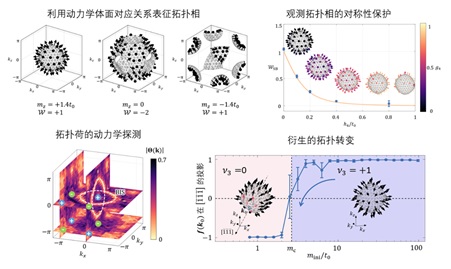Peking University, August 8, 2020: Recently, Professor Liu Xiongjun’s group at the International Center for Quantum Materials (ICQM) of Peking University, together with Professor Du Jiangfeng and Professor Wang Ya at University of Science and Technology of China, published a paper in Phys. Rev. Lett. reporting a progress on quantum simulation for 3D chiral topological phase [Phys. Rev. Lett. 125, 020504 (2020)]. This is the latest progress on the topic of characterization of equilibrium topological phases by non-equilibrium quantum dynamics, as proposed by Liu’s group in the recent years.
Quantum simulation, as a state-of-the-art technique, provides a powerful way to explore topological quantum phases beyond natural limits. Nevertheless, it is usually hard to simulate both the bulk and surface topological physics at the same time to reveal their correspondence. In the recent paper published in PRL, Professor Liu at PKU, Professor Du and Professor Wang at USTC build up a quantum simulator using nitrogen-vacancy center to investigate a three-dimensional (3D) chiral topological insulator which was not realized in solid state system, and demonstrate a complete study of both the bulk and surface topological physics by quantum quenches. First, a dynamical bulk-surface correspondence in momentum space is observed, showing that the bulk topology of the 3D phase uniquely corresponds to the nontrivial quench dynamics emerging on 2D momentum hypersurfaces called band inversion surfaces (BISs), the concept proposed by Liu et al in a series of previous publications (see e.g. Science Bull. 63, 1385). This is the momentum-space counterpart of the bulk-boundary correspondence in real space. Further, the symmetry protection of the 3D chiral phase is uncovered by measuring dynamical spin textures on BISs, which exhibit perfect (broken) topology when the chiral symmetry is preserved (broken). Finally, they measure the topological charges to characterize directly the bulk topology and identify an emergent dynamical topological transition when varying the quenches from deep to shallow regimes. This work demonstrates how a full study of topological phases can be achieved in quantum simulators.

Graduate students Ji Wentao (USTC) and Zhang Ling (PKU) are co-first authors of the paper. This work was supported by NSFC, MOST, and CAS.
Source: International Center for Quantum Materials, Peking University
